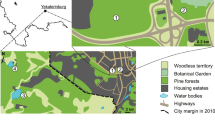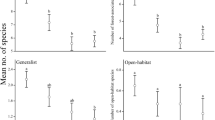Abstract
The occurrence of carabid beetles in relation to trampling was examined in urban forest sites located in the city of Helsinki, southern Finland. The degree of wear of the forest floor was assessed and used as a measure of trampling intensity. In particular, we examined the following predictions: (1) carabid diversity should decrease with increasing trampling intensity, (2) mean body size of the dominating carabid species should decrease with increasing trampling intensity, and (3) opportunistic species should gain dominance in severely trampled sites. In total, 1,326 beetles representing 27 species were captured. The first prediction was not supported, as there was no correlation between species richness or Hill's N2 diversity index and trampling intensity. However, there was a positive correlation between number of carabids captured and trampling intensity of the site. The second hypothesis gained some support, as there was a marginally significant negative correlation between body size and trampling intensity. The hypothesis that opportunistic species should gain dominance in severely trampled sites was supported as one species was very dominant (Pterostichus melanarius, 60.0%) in the heavily trampled sites, while there were two equally and less dominant species in the less trampled sites. Individual species did show different responses to the effects of trampling, and the most sensitive forest species may not survive in the heavily trampled sites. We conclude that at the community level (e.g., species richness, diversity), the effects of trampling on carabids in urban forests are subtle, but impacts are pronounced for some sensitive species.
Similar content being viewed by others
References
Blake, S., Foster, G.N., Eyre, M.D. and Luff, M.L. (1994) Effects of habitat type and grassland management practises on the body size distribution of carabid beetles. Pedobiologia 38, 502–512.
Blake, S., Foster, G.N., Fischer, G.E.J. and Ligertwood, G.L. (1996) Effects of management practices on the carabid fauna of newly established wildflower meadows in southern Scotland. Annales Zoologici Fennici 33, 139–147.
Brown, K.S., Jr. (1997) Diversity, disturbance and sustainable use of Neotropical forests: insects as indicators for conservation monitoring. Journal of Insect Conservation 1, 25–42.
Czechowski, W. (1982) Occurrence of carabids (Coleoptera, Carabidae) in the urban greenery of Warsawaccording to the land utilization and cultivation. Memorabilia Zoologica 39, 2–108.
Davis, B.N.K. (1978) Urbanization and the diversity of insects. In Diversity of Insect Faunas (L.A. Mound and N. Waloff, eds.), pp. 126–138. Symp. Royal Entomol. Soc. Lond. 9. Blackwell, Oxford.
Den Boer, P.J. (1986) Carabids as objects of study. In Carabid Beetles. Their Adaptations and Dynamics (P.J. Den Boer, M.L. Luff, D. Mossakowski and F. Weber, eds.), pp. 539–551. Gustav Fisher, Stuttgart.
Eyre, M. and Luff, M. (1990) A preliminary classification of European grassland habitats using carabid beetles. In Ground Beetles: Their Role in Ecological and Environmental Studies (N. Stark, ed.), pp. 227–236. Intercept Publications, Andover.
Frankie, G.W. and Ehler, L.E. (1978) Ecology of insects in urban environments. Annual Review of Entomology 23, 367–387.
Gaston, K.J. and Lawton, J.H. (1988) Patterns in the distribution and abundance of insect populations. Nature 331, 709–712.
Gilbert, O.L. (1989) The Ecology of Urban Habitats. Chapman and Hall, London.
Gray, J.S. (1987) Species–abundance patterns. In Organization of Communities, Past and Present (J.H.R. Gee and P.S. Giller, eds.), pp. 53–67. Blackwell Scientific Publications, Oxford.
Gray, J.S. (1989) Effects of environmental stress on species rich assemblages. Biological Journal of the Linnean Society 37, 19–32.
Grüm, L. (1984) Carabid fecundity as affected by extrinsic and intrinsic factors. Oecologia 65, 114–121.
Halme, E. and Niemelä, J. (1993) Carabid beetles in fragments of coniferous forest. Annales Zoologici Fennici 30, 17–30.
Jarišik, V. (1989) Mass vs. length relationship for carabid beetles (Col., Carabidae). Pedobiologia 33, 87–90.
Klausnitzer, B. (1983a) Presence of an urban gradient demonstrated for carabid associations. Oecologica 59, 79–82.
Klausnitzer, B. (1983b) Faunistisch–ökologische Untersuchungen öber die Laufkäfer (Col., Carabidae) des Stadtgebietes von Leipzig. Entomologische Nachrichten und Berichte 27, 241–259.
Lehvävirta, S. (1999) Structural elements as barriers against wear in urban woodlands. Urban Ecosystems 3, 45–56.
Lindroth, C.H. (1985) The Carabidae (Coleoptera) of Fennoscandia and Denmark, Part 1. Brill, Leiden; Scandinavian Science Press, Copenhagen.
Lindroth, C.H. (1986) The Carabidae (Coleoptera) of Fennoscandia and Denmark, Part 2. Brill, Leiden; Scandinavian Science Press, Copenhagen.
Lindroth, C.H. (1992) Ground Beetles (Carabidae) of Fennoscandia. A Zoogeographical Study, Part III. Smithsonian Institute Libraries, Washington, DC.
Loreau, M. (1992) Species abundance and the structure of ground–beetle communities. Annales Zoologici Fennici 28, 49–56.
Lövei, G.L. and Sunderland, K.D. (1996) Ecology and behavior of ground beetles (Coleoptera: Carabidae). Annual Review of Entomology 41, 231–256.
Ludwig, J.A. and Reynolds, J.F. (1988) Statistical Ecology. John Wiley, New York.
Luff, M. (1996) Use of carabids as environmental indicators in grasslands and cereals. Annales Zoologici Fennici 35, 185–195.
Magurran, A.E. (1988) Ecological Diversity and its Measurement. Princeton University Press, Princeton.
McDonnell, M.J., Pickett, S.T.A., Groffman, P., Bohlen, P., Pouyat, R.V., Zipperer, W.C., Parmelee, R.W., Carreiro, M.M. and Medley, K. (1997) Ecosystem processes along an urban–to–rural gradient. Urban Ecosystems 1, 21–36.
New, T.R. (1998) The role of ground beetles (Coleoptera, Carabidae) in monitoring programmes in Australia. Annales Zoologici Fennici 35, 163–171.
Niemelä, J. (1993) Mystery of the missing species: species–abundance distribution of boreal ground–beetles. Annales Zoologici Fennici 30, 169–172.
Niemelä, J. (1999) Ecology and urban planning. Biodiversity and Conservation 8, 119–131.
Niemelä, J. (2000) Is there a need for a theory of urban ecology? Urban Ecosystems 3, 57–65.
Niemelä, J. (2001) Carabid beetles (Coleoptera, Carabidae) indicating habitat fragmentation: a review. European Journal of Entomology 98, 127–132.
Niemelä, J. and Spence, J.R. (1991) Distribution and abundance of an exotic ground–beetle (Carabidae): a test of community impact. Oikos 62, 351–359.
Niemelä, J. and Spence, J.R. (1994) Distribution of forest dwelling carabids (Coleoptera): spatial scale and the concept of communities. Ecography 17, 166–175.
Niemelä, J., Spence, J.R., Langor, D., Haila,Y. and Tukia, H. (1994) Logging and boreal ground–beetle assemblages on two continents: implications for conservation. InPerspectives in Insect Conservation (K. Gaston, M. Samways and T. New, eds.), pp. 29–50. Intercept Publications, Andover.
Niemelä, J., Kotze, J., Ashworth, A., Brandmayr, P., Desender, K., New, T., Penev, L., Samways, M. and Spence, J. (2000) The search for common anthropogenic impacts on biodiversity: a global network. Journal of Insect Conservation 4, 3–9.
Niemelä, J., Kotze, J., Venn, S., Penev, L., Stoyanov, I., Spence, J., Hartley, D. and Montes de Oca, H. (2002) Carabid beetle assemblages (Coleoptera, Carabidae) across urban–rural gradients: an international comparison. Landscape Ecology, in press.
Parmenter, R.R. and MacMahon, J.A. (1984) Factors influencing the distribution and abundance of ground dwelling beetles (Coleoptera) in a shrub–steppe ecosystem: the role of shrub architecture. Pedobiologia 26, 21–34.
Pearsall, I.A. and Walde, S.J. (1995) A comparison of epigaeic coleoptera assemblages in organic, conventional, and abandoned orchards in Nova Scotia, Canada. Canadian Entomologist 127, 641–658.
Rushton, S.P., Luff, M.L. and Eyre, M.D. (1989) Effects of pasture improvement and management on the ground beetle and spider communities of upland grasslands. Journal of Applied Ecology 26, 489–503.
Simberloff, D.S. (1978) Use of rarefaction and related methods in ecology. In Biological Analysis (K.L. Dickson, J. Gariens, Jr. and R.J. Livingston, eds.), pp. 150–165. American Society for Testing and Materials.
Šustek, Z. (1987) Changes in body size structure of carabid communities (Coleoptera, Carabidae) along an urbanisation gradient. Biológia (Bratislavia) 42, 145–156.
Šustek, Z. (1992) Changes in the representation of carabid life forms along an urbanisation gradient (Coleoptera, Carabidae). Biológia (Bratislava) 47, 417–430.
Tietze, F. (1985) Veränderungen der Arten–und Dominanzstruktur in Laufkäfertaxozönose (Coleoptera–Carabidae) bewirtschafteter Graslandökosysteme durch Intensivierungsfaktoren. Zool. Jb. Syst. 112, 367–382.
Trepl, L. (1995) Towards a theory of urban biocoenoses. In Urban Ecology as the Basis for Urban Planning (H. Sukopp, M. Numata and A. Huber, eds.), pp. 3–21. SPB Academic Publishing, The Hague.
Author information
Authors and Affiliations
Rights and permissions
About this article
Cite this article
Grandchamp, AC., Niemelä, J. & Kotze, J. The effects of trampling on assemblages of ground beetles (Coleoptera, Carabidae) in urban forests in Helsinki, Finland. Urban Ecosystems 4, 321–332 (2000). https://doi.org/10.1023/A:1015707916116
Issue Date:
DOI: https://doi.org/10.1023/A:1015707916116




